There are currently 174 named moons in our Solar System, orbiting the six outermost planets, with more being discovered and debated every day. Some are more fascinating than others, whether it’s their landscapes, features, orbits or environments - so we ranked our top 20 most interesting moons, because, well, why not…
1
Dactyl - The Alternative Moon
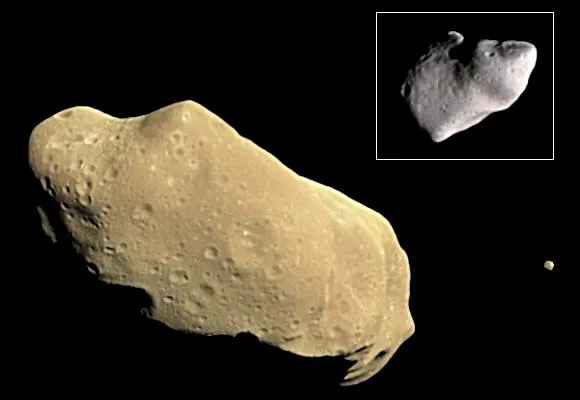
Orbits:Asteroid 243 Ida
Discovered in 1995 by the Galileo probe, this moon is less than a mile in diameter and is the natural satellite to the asteroid Ida, a Koronis asteroid located in the belt between Mars and Jupiter. Before this, scientists had no evidence that asteroids could have moons, but since its discovery a further 24 have been found to orbit them.
The origin of the unorthodox moon is debated, and could either be from the asteroid itself, or a captured object.
2
Charon - Pluto’s Other Half

Orbits:Pluto
A perhaps controversial decision to select a moon of an ex-planet, but an interesting moon all the same!
At half the size of Pluto, the pair are often referred to as a double dwarf planet system, particularly as they orbit around a central point in space as opposed to Pluto being the centre of orbit.
The moon was discovered when theHubble Space Telescopecaptured images of Pluto looking more elongated than its usual spherical shape.
Its name comes from the mythological ferryman who used to carry souls across to the realm of the dead, requiring a coin to allow the dead to proceed to the underworld. TheNew Horizonsspacecraft symbolically carried a Florida state quarter to pay the ferryman, as it passed by Charon and Pluto in 2015.
3
Atlas - The UFO

Orbits:Saturn
Similar to Pan, Saturn’s other innermost moon, Atlas has an equatorial ridge giving the moon its distinctive flying saucer shape. With an average radius of 15 km, the small moon Atlas was discovered in 1980 using images from theVoyager 1 probeduring its flyby of Saturn.
Its close proximity to Saturn means it completes one orbit of its mother planet in just 14.4 hours.
Listen to the Science Focus Podcast:
4
Hyperion - The Space Sponge
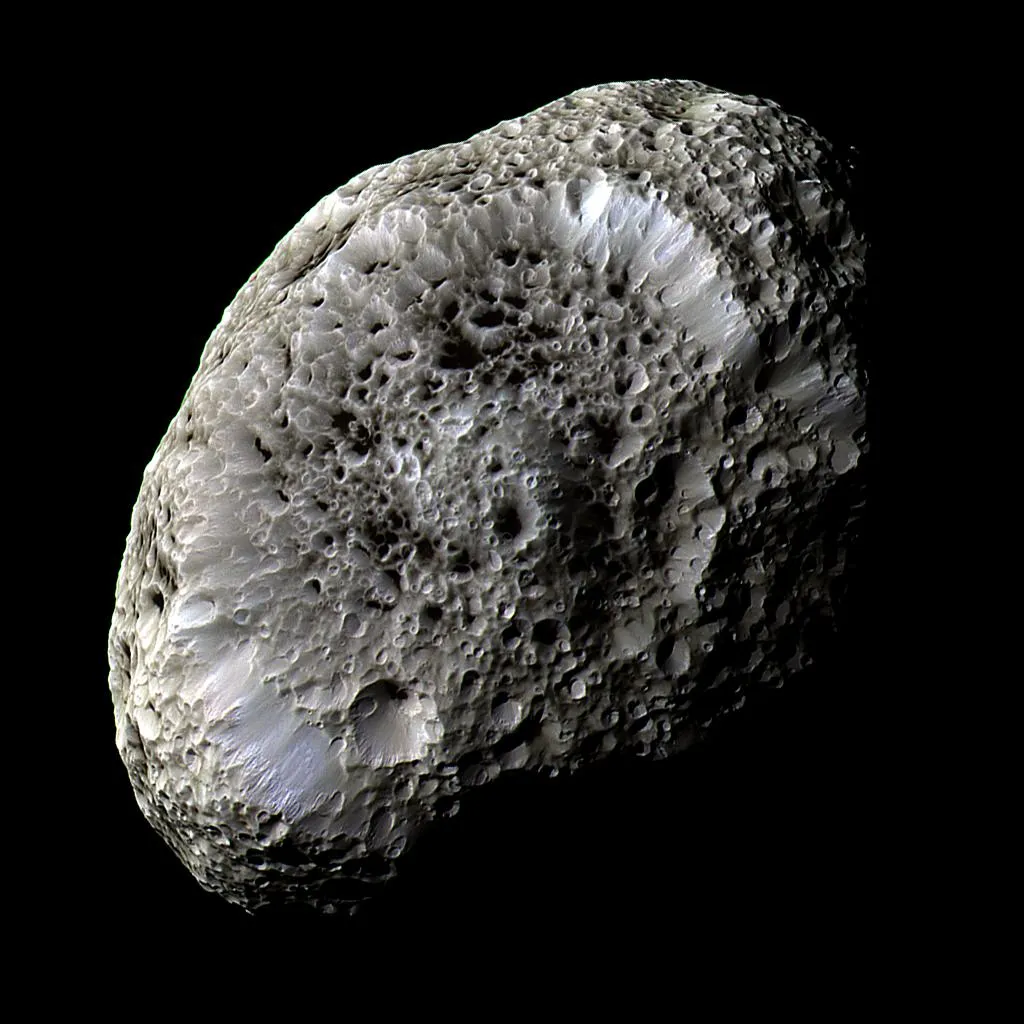
Orbits:Saturn
Hyperion is an irregular shaped moon, in that it is not spherical, and is likely a fragment of a much larger, ancient moon destroyed from an impact in the early Solar System.
The moon has a very low density, nearly half that of water, and alongside its deeply cratered surface, gives Hyperion its porous, spongy appearance. The craters remain as it is one of Saturn’s outermost moons, experiencing almost no tidal forces, which would slowly fill these deeply excavated impact craters.
5
Mimas - That’s No Moon…
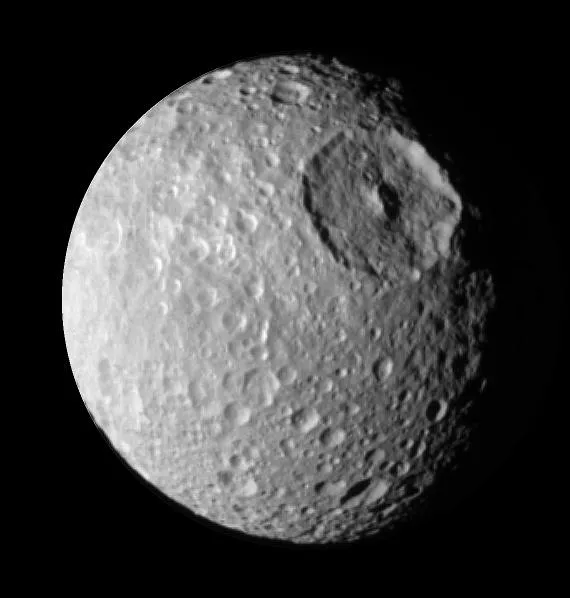
Orbits:Saturn
The resemblance of Saturn’s moon Mimas to an iconic moon-shaped fictional space station is largely the fault of a giant impact crater that covers a third of its diameter.
The crater measures 130 km across with a 5km surrounding walls is known as the Herschel Crater, after William Herschel who spotted the moonin 1789. The body that struck the moon almost ripped it apart, as evidenced by the fractures on the opposite face of Mimas. The moon is littered with craters, showing a lack of surface replenishment despite its close proximity to Saturn and elliptical orbit, which should provide enough heat through gravitational tidal activity.
Mimas is also tidally locked, with the same face towards Saturn throughout its 22.5 hour orbit of the planet. Mimas also disrupts the orbits of much smaller moons, and speeds up when passing the large moons Enceladus and Dione.
Oh, and if you haven’t worked it out by now, the moonlooks like the Death Star from Star Wars.
6
Iapetus - A Tale of Two Faces
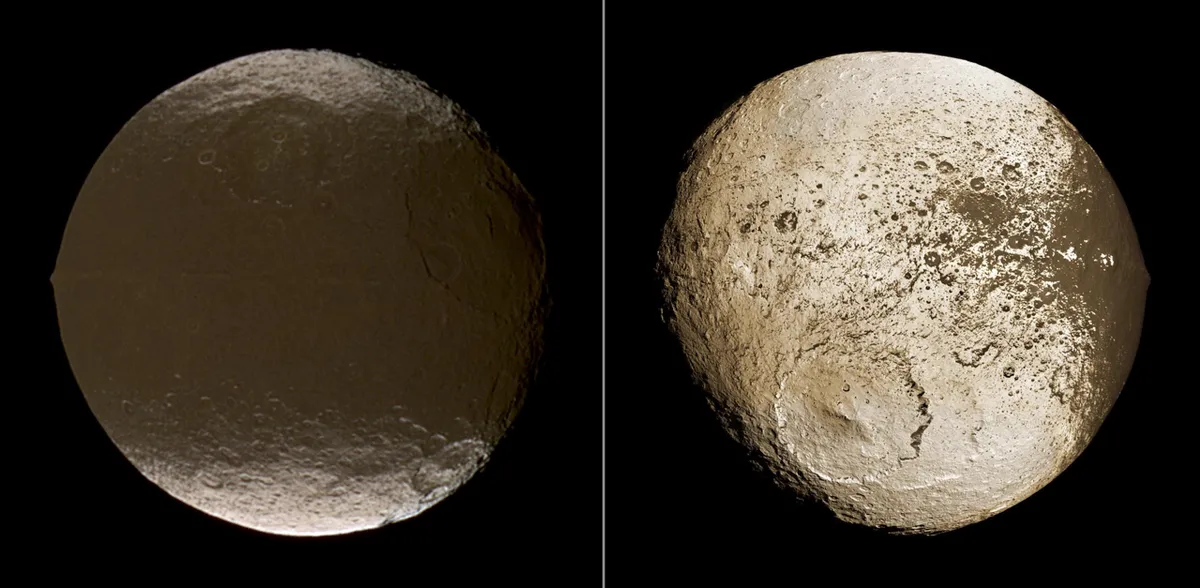
Orbits:Saturn
Iapetus is tidally locked to Saturn (the same side is always facing the planet), despite the distance from its mother planet. This made Iapetus difficult to spot, as it mysteriously became brighter and fainter as it completed its orbit of Saturn. In 1671, Cassini observed this difference and correctly predicted that the moon had two faces, one bright, and one impossibly dark.
There are few explanations for the dark side of the moon, involving volcanic eruptions of hydrocarbons darkened by chemical reactions initiated by solar radiation, or that the moon is collecting particles from a nearby dark moon, Phoebe.
The most likely responsible process was postulated after aCassini probeflyby in 2007, thermal segregation, where the darker particles absorb more heat from the Sun, so any brighter volatiles within this region sublime out, and move to the cooler, brighter side, while the dark side becomes even darker.
The yin and yang moon also features an equatorial ridge, rising 13 km above the surface, like a walnut.
7
Pan - The Ring Sculptor
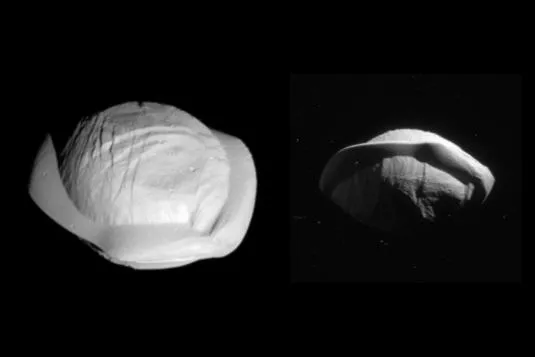
Orbits:Saturn
This small moon was first discovered by the Voyager 2 probe in 1990 after capturing an image of the innermost rings, featuring the tiny speck of Pan (14 km in diameter) in the 325 km wide Encke Gap.
The saucer shape moon influences the particles in the ring system, by producing kinks known as wakes. When the fast moving particles pass Pan, the moon gives them a gravitational ‘kick’, and they bunch up to produce the waves that can extend many hundreds of miles into the rings.
8
Nereid - The Wanderer

Orbits:Neptune
Neptune’s Nereid possesses the most eccentric orbit of any moon in our Solar System, taking 360 Earth-days to orbit the planet. As one of the outermost moons, Nereid can be as close as 841,100 km away and as far out as 5,980,200 km away during its extreme elongated elliptical orbit.
This strange orbit has lead astronomers to believe that the moon is a captured object from the Kuiper Belt, a region of icy bodies beyond Neptune ranging from a trillion comet sized objects to those larger than 100 km in diameter (includingPluto).
9
Callisto - The Solar System’s Pin Cushion

Orbits:Jupiter
After being one of four moons discovered orbiting a different planet to Earth in 1610 by Galileo, Callisto provided understanding into the workings of the Solar System, and how the Sun is at its centre, rather than the Earth.
It is the outermost Jovian moon, and has been constantly battered by asteroid impacts making it the most cratered body in our Solar System.
Due to a lack of geologic activity, the moon is unable to replenish its surface, displaying craters as old as 4 billion years - making Callisto the oldest landscape in the Solar System.
10
Phobos - On Course for Trouble

Orbits:Mars
Phobos is the larger of Mars’ two moons, and is irregular, non-spherical in shape measuring 27x22x18 km. The moon orbits so close to its parent planet that it completes three orbits in one day!
Its most noticeable feature is the Stickney crater, 9.7 km across, left behind from an impact that nearly shattered the moon. Constant bombardment of meteors has left the surface covered in a fine dust.
At first glance, Phobos seems like an uninteresting object in the sky overMars, but has a catastrophic future ahead, and it’s this eventual demise that gets Phobos onto our top 20 list of interesting moons.
The moon is gradually getting closer to the Red Planet at a rate of 1.8 m every hundred years, and the two will ultimately collide in 50 million years. Alternatively, the moon will be broken down by impacts, forming a fine dusty ring around its parent planet.
Listen to the Science Focus Podcast:
11
Ganymede - The King of the Moons
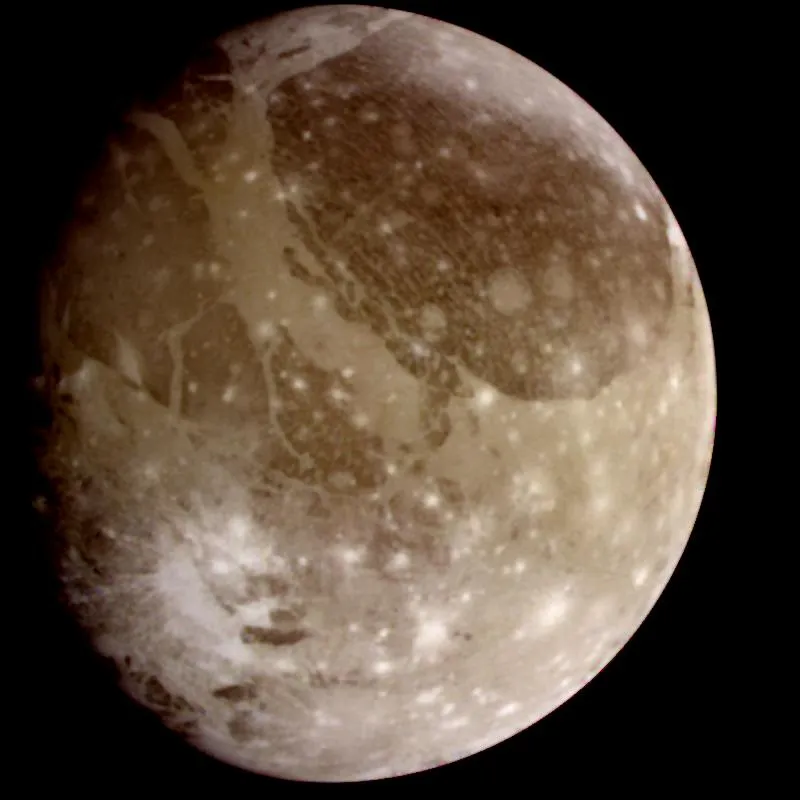
Orbits:Jupiter
The Jovian moon is the largest in theSolar System, and even larger than the first planet in our system, Mercury – it would definitely be given planetary status if it orbited the Sun directly. The icy-rock surface has both craters and grooves, and a molten core, which allows it to possess its own magnetosphere within that of Jupiter.
In 1996, the Hubble Telescope detected a thin atmosphere surrounding the moon, containing oxygen. However, its far too thin to support life - at least that we know of.
12
Miranda - Frankenstein’s Moon
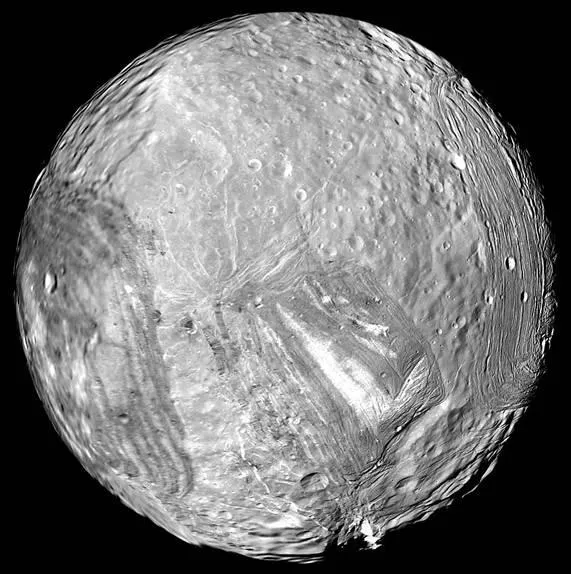
Orbits:Uranus
At 500 km in diameter, the small moon was unlikely to exhibit any tectonic activity, yet Miranda’s surface is littered with canyons, 12 times as deep as Earth’s Grand Canyon. Miranda’s surface can be divided into separate regions with differing levels of features, from smooth to cratered, and was first imaged during the Voyager 2 flyby of Uranus in 1986 - the closest object in the probe’s trajectory.
The possibility for the moon’s mismatched surface is that the moon had been previously destroyed in an impact event in the early Uranian system, and then reaggregated due to the gravitational attraction of the large fragments.
13
Epimetheus and Janus - The Twins

Orbits:Saturn
This may appear as cheating to choose two moons, but these irregular rocky bodies were originally combined as one moon in an earlier Saturn system, and when discovered, were thought to be the same object.
The interesting feature of this pair is their co-orbital condition, as they follow the same path aroundSaturn, but one is 50 km further from the planet. This means the inner moon travels slightly faster around the planet, and catches up to the outer moon every four years. At this point, the gravitational influence on one another causes the moons to essentially swap places, so the outer becomes the inner and vice versa.
They are located in a faint dusty ring of Saturn, which was likely produced by the material ejected after meteor impacts on both Janus and Epimetheus.
14
Triton - A Volcanic Space Melon
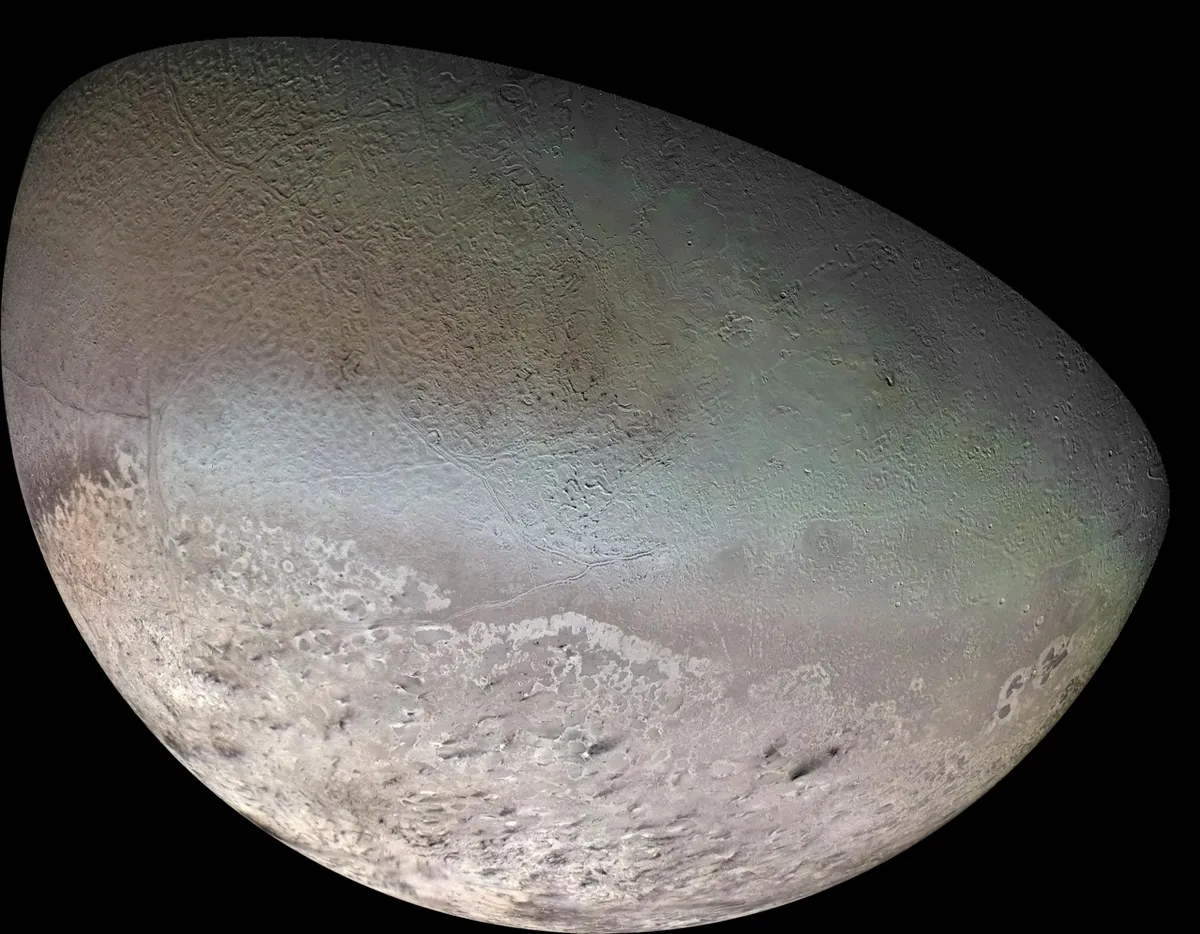
Orbits:Neptune
Triton is likely a captured Kuiper Belt object, held in orbit by the strong gravitational pull of Neptune. The moon possesses a thin atmosphere, with abundances of nitrogen and methane, produced through volcanic activity at its surface.
When Voyager 2 passed by Triton in 1989, erupting geysers werean unexpected featureon the cold, scaly ‘cantaloupe’ moon. The surprising trait was revealed through images taken of the southern pink cap, showing dark streaks left behind on the surface from the carbonaceous plumes. It is one of the few volcanically active bodies in our Solar System, despite its 4.5 billion km distance from the Sun.
It still remains one of the coldest places, with most of the nitrogen existing as a frost, which gives the moon its highly reflective surface.
15
Titan - A Terrain fit for Tolkien
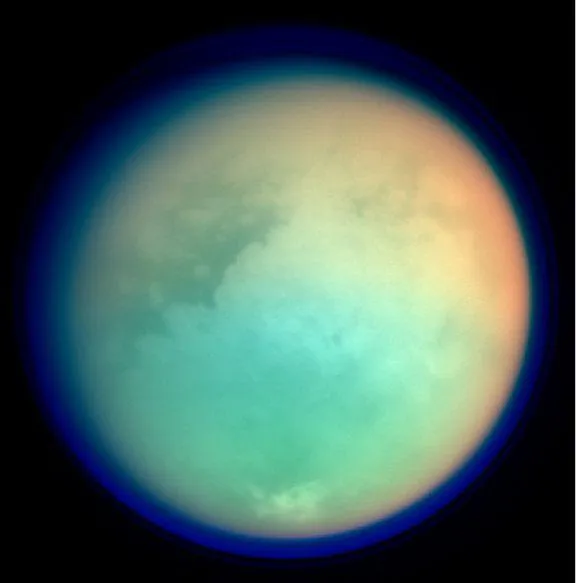
Orbits:Saturn
At only two per cent smaller than Ganymede, Titan is the second largest moon in our Solar System. It is the only moon known to exhibit a thick atmosphere, dense enough that the solid core of the planet is completely obscured by the nitrogen and methane clouds. UV radiation from the Sun also initiates reactions to occur between these gases, producing many different organic molecules, existing as trace abundances in Titan’s atmosphere.
The Cassini probe revealed lakes and rivers of ethane and methane, which are filled by the rains from the orange clouds, as well as dark sand-like dunes comprised of hydrocarbon grains. Any volcanic activity is likely to produce water instead of the molten rock as we know here on Earth. Mountains on the surface of Titan are named after those found in JRR Tolkien’s Middle Earth.
16
Io - The Moon with a Fiery Attitude

Orbits:Jupiter
As the most volcanic body in our Solar System, Io is Jupiter’s third largest moon. The supply of heat is caused by its elliptical orbit, forced to follow this path by the larger moons Ganymede and Europa, and that the same side of the moon is always facing the planet. This produces incredible tidal forces due to the changing gravitational pull on Io, causing its solid surface to bulge out by as much as 100m.
As a result, the subsurface of the moon is almost entirely molten, with itsvolcanoeserupting matter as high as 190 miles into the atmosphere, filling any impact craters to form lava lakes and liquid rock floodplains. Io is continuously replenishing its surface, the composition of which is currently debated between the heat withstanding silicon, and the colour varying sulphur.
17
Rhea - Put a Ring on it

Orbits:Saturn
A desolate landscape, with temperatures plummeting to -220 degrees Celsius in the shade, cratered and grey. Rhea was expected to be just another moon comprised of rock and ice - but that was until the Voyager and Cassini space probes arrived.
In 1980, The Voyager probe’s images depicted Rhea’s craters and brighter canyons of exposed ice. Then Cassini arrived in 2008, finding evidence of ring structures orbiting Rhea, the first time this property was observed for a moon. The discoveries continued in 2010, when Cassini detected a thin atmosphere containing oxygen and carbon dioxide surrounding the moon - the first time oxygen had been directly collected by a space probe. The oxygen arises from energetic particles in the surface ice reacting and decomposing to release the gas into the atmosphere, a process that occurs when Rhea passes through Saturn’s magnetosphere. In the distant future of Rhea, the increased levels of oxygen in the atmosphere could drive more complex chemistry to occur on the surface on the moon.
18
Europa - The Solar System’s Cue Ball
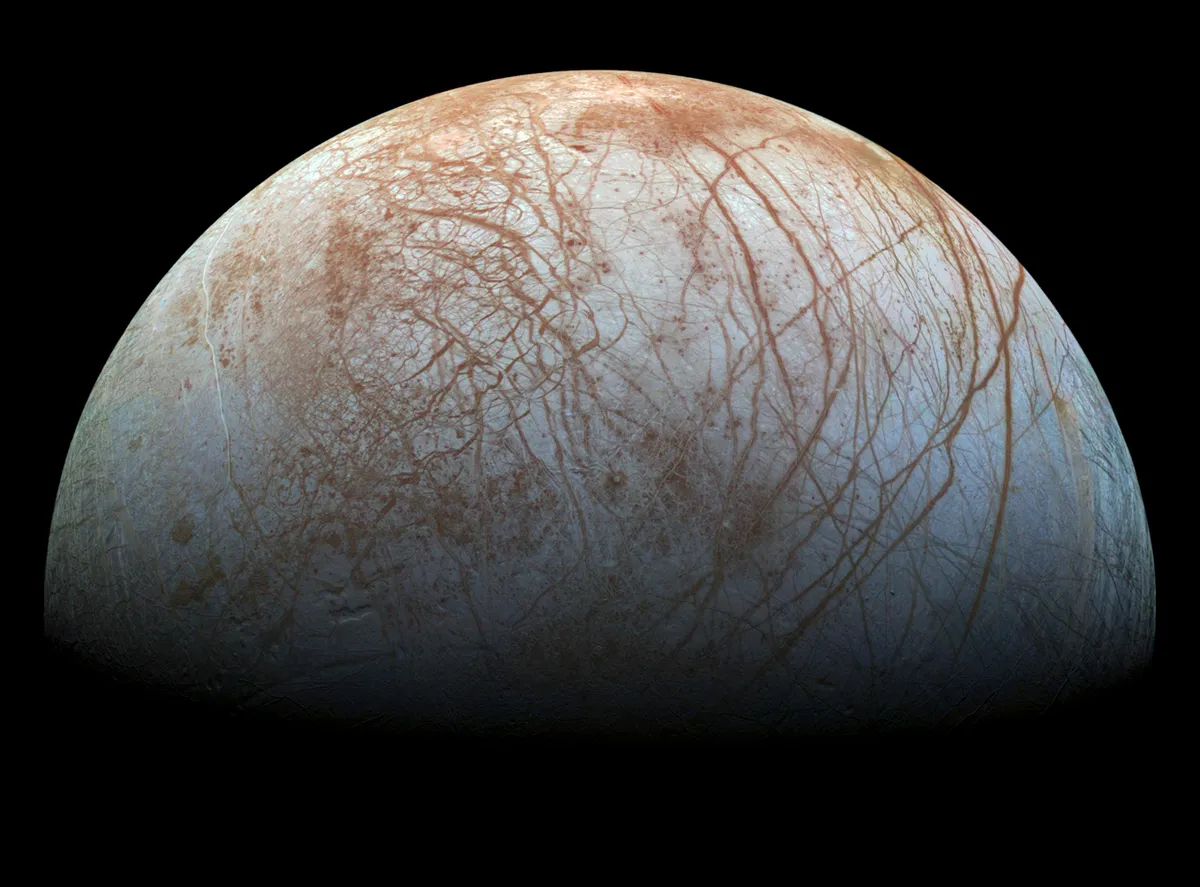
Orbits:Jupiter
Only fractionally smaller than our Moon (Updated: not planet Earth as we originally stated), the icy Jovian moon has many curious features of interest, which are stimulating plans for future space probe missions. Almost entirely free of craters, the moon is possibly the smoothest object in the Solar System, smoother than a snooker ball.
The 62 mile thick surface is fractured with intersecting red-brown deposits of an unknown material, which obscures the possible presence of an ocean below. The existence of water, combined with the warmth and tides caused by Jupiter’s gravitational pull, has inspired thoughts that these oceans could harbour early life. In 2013, NASA announced that Europa could beerupting water into spaceafter viewing images from the Hubble Telescope. This indicates that the core could be geologically active, and produce vents underwater also, which would provide vital nutrients to the organisms that may thrive here.
19
The Moon - The One and Only
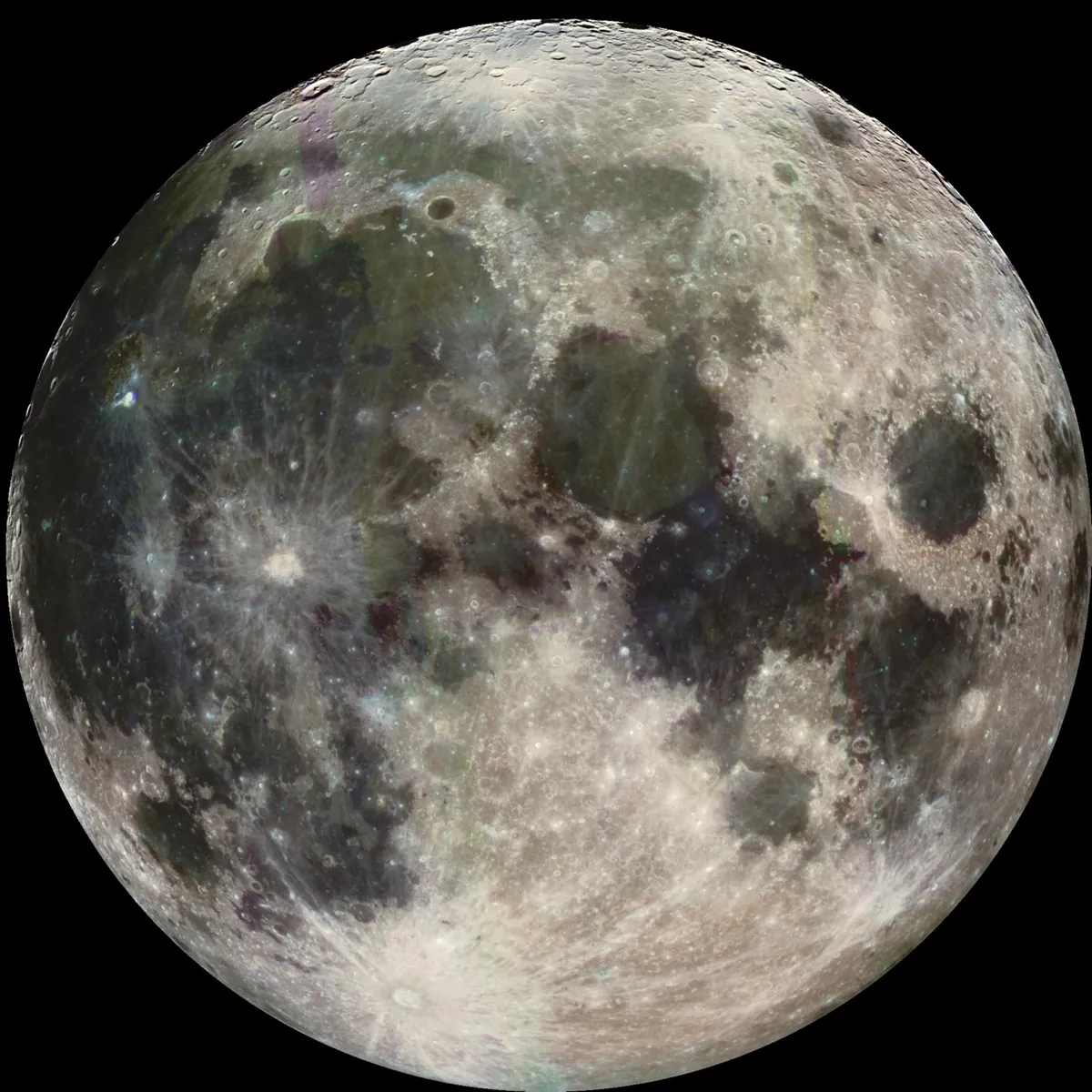
Orbits:Earth
No list of interesting moons would be complete without the original wonder of the night sky, our Moon. It is often said that we know more about its surface than our planet’s oceans.
Our moon is the fifth largest natural satellite in the Solar System and remains the only place outside of Earth where humans have set foot. Observed by all life on our planet for millennia, the Moon was a mysterious cratered object, inspiring many myths and legends, and is of great importance to many cultures, withSolar and Lunar eclipsesbeing symbolic to their beliefs.
The Moon is also vital for our planet to maintain life. It moderates our planet’s axis wobble, causing a more stable climate and creates the Earth’s natural rhythm, the tides of our oceans.
Our Moon surface shows both light and dark areas (known as highlands and maria respectively), with different compositions and ages, suggesting that the early moon had a molten crust that crystallised to form the lunar landscape we observe today. The craters, as well as the footprints of astronauts, will be preserved for billions of years, as the Moon doesn’t replenish its surface as others do throughout the Solar System. The Moon does have a very thin atmosphere, known as an exosphere, but is not enough to defend it from the Sun’s radiation or meteor impacts, unlike our own protective atmosphere. The accepted theory of the Moon’s formation is that a Mars-sized body (named Theia) collided with our planet, approximately 4.5 billion years ago. Without this catastrophic event, often called the Giant-Impact Hypothesis or the Theia Impact, our planet would otherwise likely be uninhabitable.
Since being visited by ourselves and robots,the Moonhas revealed no evidence to suggest life could exist there, yet is always fantasised as the site for future human colonisation and as a launch pad to beyond the stars.
20
Enceladus - The Exciting Possibility
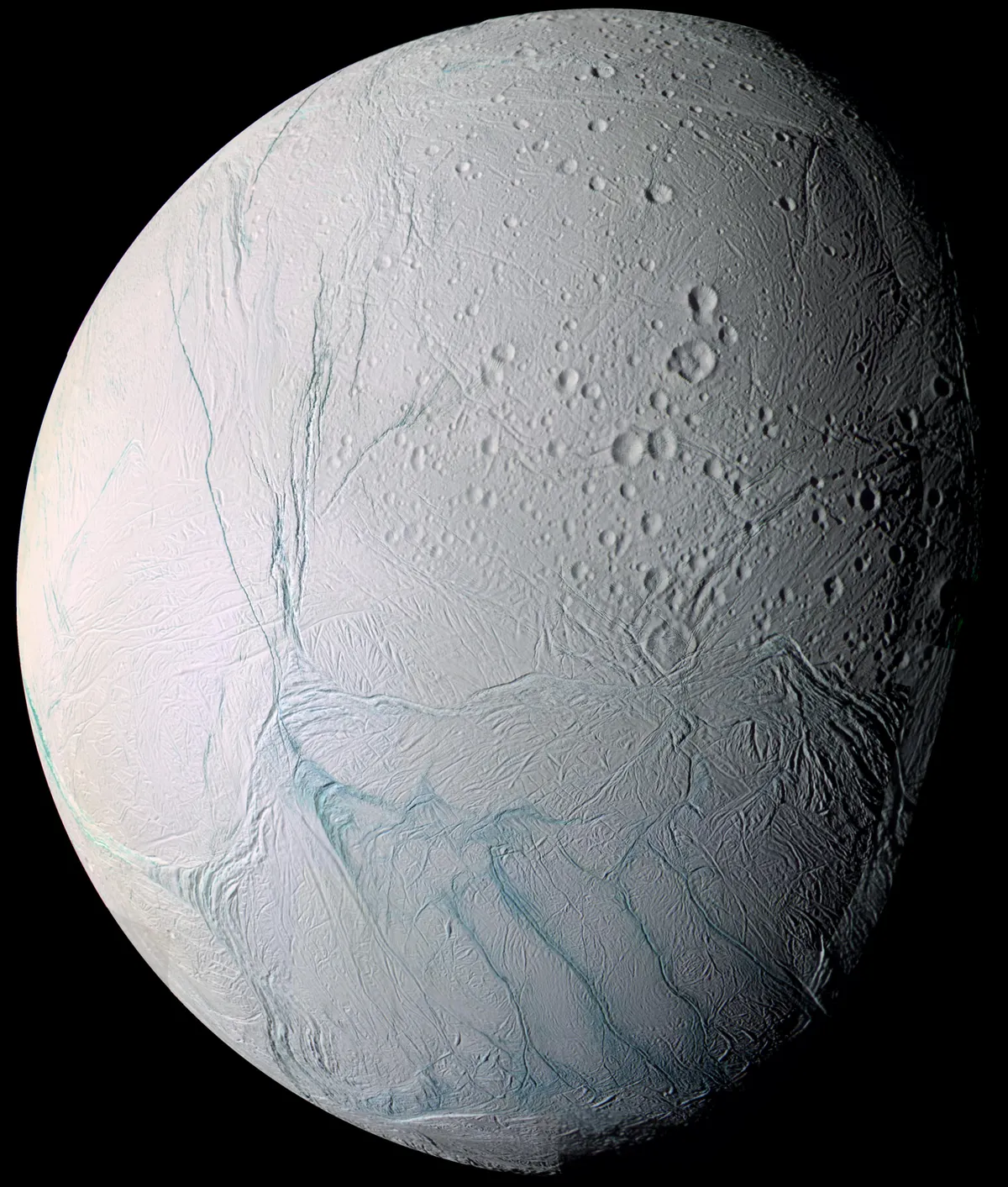
Orbits:Saturn
Enceladus is one of the brightest objects in our Solar System, as its water ice surface reflects almost 100 per cent of the Sun’s light - but this physical characteristic isn’t what makes it one of the most thrilling places in our Solar System.
The icy moon is often described as the most scientifically compelling place in our Solar System, and rightly so, as it has the most promising conditions for harbouring life outside of our planet.
In 2005, the Cassini probe discovered an incredibly exciting feature of the moon - ice geysers. The plumes from the geysers include ice particles, as well as gaseous water vapour, carbon dioxide, methane, ammonia and nitrogen. These eruptions replenish the surface with new ice, as well as provide the icy material to Saturn’s E-ring. Water vapour is heavily located above a geothermal feature on its surface known as the ‘Tiger Stripes’, deep crevasses in the otherwise smooth moon. The source of heat is likely provided through tidal forces, warming the core of the planet and causing the geological activity.
The moon is also hiding an important secret - a global-sized ocean of water, as evidenced by thewobble in its orbit, which can only be caused by a liquid interior. The factors of internal heat, chemistry and oceanic presence lead Enceladus to its great potential of the existence of life.